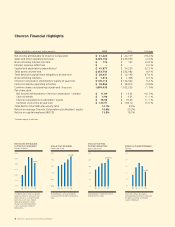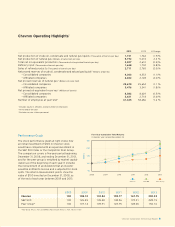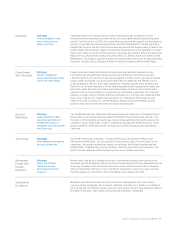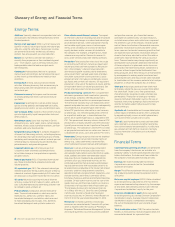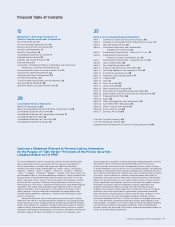Chevron 2013 Annual Report Download - page 14
Download and view the complete annual report
Please find page 14 of the 2013 Chevron annual report below. You can navigate through the pages in the report by either clicking on the pages listed below, or by using the keyword search tool below to find specific information within the annual report.
Management’s Discussion and Analysis of
Financial Condition and Results of Operations
12 Chevron Corporation 2013 Annual Report
MCF. Fluctuations in the price of natural gas in the United
States are closely associated with customer demand relative to
the volumes produced in North America.
Outside the United States, price changes for natural gas
depend on a wide range of supply, demand and regulatory
circumstances. In some locations, Chevron is investing in
long-term projects to install infrastructure to produce and
liquefy natural gas for transport by tanker to other markets.
International natural gas realizations averaged $5.91 per MCF
during 2013, compared with $5.99 per MCF during 2012.
(See page 18 for the company’s average natural gas realizations
for the U.S. and international regions.)
e company’s worldwide net oil-equivalent production
in 2013 averaged 2.597 million barrels per day. About one-
fth of the company’s net oil-equivalent production in 2013
occurred in the OPEC-member countries of Angola, Nigeria,
Venezuela and the Partitioned Zone between Saudi Arabia
and Kuwait. OPEC quotas had no eect on the company’s
net crude oil production in 2013 or 2012. At their December
2013 meeting, members of OPEC supported maintaining the
current production quota of 30 million barrels per day, which
has been in eect since December 2008.
e company estimates that oil-equivalent production
in 2014 will average approximately 2.610 million barrels per
day, based on an average Brent price of $109 per barrel for
the full-year 2013. is estimate is subject to many factors
and uncertainties, including quotas that may be imposed
by OPEC; price eects on entitlement volumes; changes in
scal terms or restrictions on the scope of company opera-
tions; delays in construction, start-up or ramp-up of projects;
uctuations in demand for natural gas in various markets;
weather conditions that may shut in production; civil unrest;
changing geopolitics; delays in completion of maintenance
turnarounds; greater-than-expected declines in production
from mature elds; or other disruptions to operations. e
outlook for future production levels is also aected by the
size and number of economic investment opportunities and,
for new, large-scale projects, the time lag between initial
exploration and the beginning of production. Investments in
upstream projects generally begin well in advance of the start
of the associated crude oil and natural gas production. A sig-
nicant majority of Chevron’s upstream investment is made
outside the United States.
Refer to the “Results of Operations” section on pages
14 through 16 for additional discussion of the company’s
upstream business.
Refer to Table V beginning on page 73 for a tabulation of
the company’s proved net oil and gas reserves by geographic
area, at the beginning of 2011 and each year-end from 2011
through 2013, and an accompanying discussion of major
changes to proved reserves by geographic area for the three-
year period ending December 31, 2013.
On November 7, 2011, while drilling a development
well in the deepwater Frade Field about 75 miles oshore
Brazil, an unanticipated pressure spike caused oil to migrate
from the well bore through a series of ssures to the sea oor,
emitting approximately 2,400 barrels of oil. e source of
the seep was substantially contained within four days and the
well was plugged and abandoned. On March 14, 2012, the
company identied a small, second seep in a dierent part
of the eld. No evidence of any coastal or wildlife impacts
0.0
12.5
7.5
5.0
10.0
2.5
Net proved reserves for
consolidated companies and
affiliated companies decreased
1 percent in 2013.
Net Proved Reserves
Billions of BOE
United States
Other Americas
Africa
Asia
Australia
Europe
Affiliates
11. 2
09 10
11
12
13
Net Proved Reserves
Liquids vs. Natural Gas
Billions of BOE
1009 11 12 13
11. 2
Natural Gas
Liquids
12.5
7.5
0.0
10.0
5.0
2.5
Reserve replacement rate in 2013
was 85 percent. Five-year average
reserve replacement rate was
100 percent.




